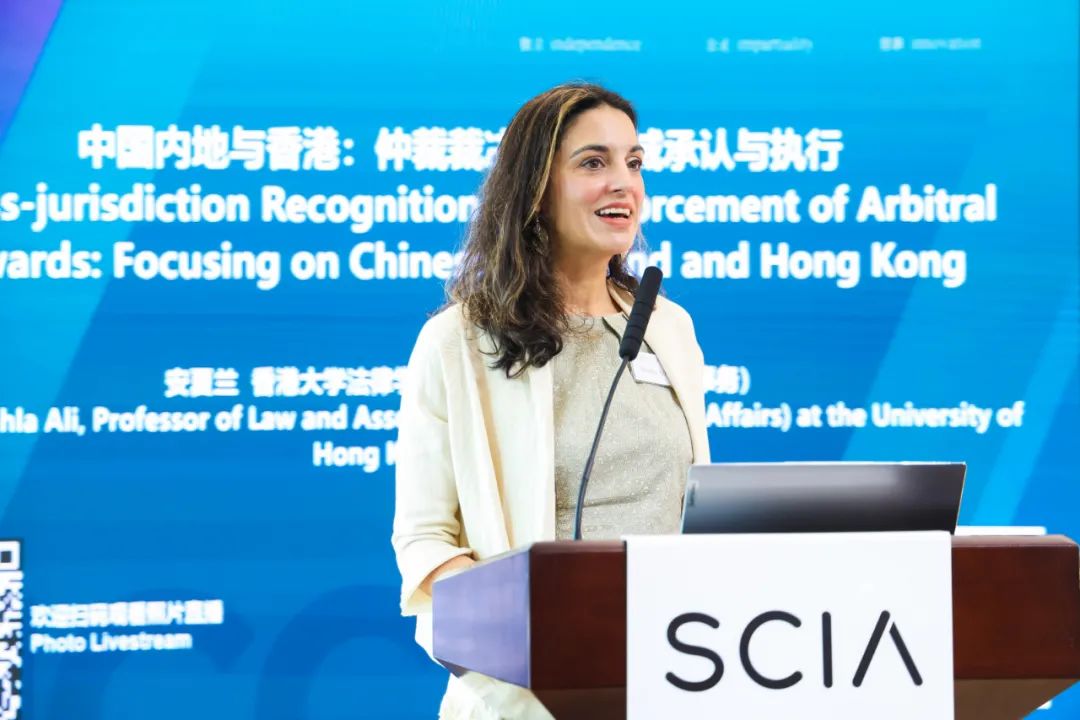
Prof. Shahla Ali: Arrangements and Developments of Cross-jurisdiction Dispute Resolution: Focusing on Chinese Mainland and the Hong Kong SAR
On 9 May 2024, the XXVIth Congress of International Council for Commercial Arbitration (ICCA 2024) Shenzhen Side Events were held at the Shenzhen Court of International Arbitration (SCIA) headquarters at SCIA Tower, Qianhai, Shenzhen. The ICCA 2024 Shenzhen Side Events were co-hosted by the SCIA and the South China International Arbitration Centre (HK) (SCIA HK), together with Department of Justice of the Hong Kong SAR Government and HKIAC. Prof. Shahla Ali, Professor of Law and Associate Dean (International Affairs) at the University of Hong Kong Faculty of Law delivered a speech on “Arrangements and Developments of Cross-jurisdiction Dispute Resolution: Focusing on Chinese Mainland and the Hong Kong SAR” during the event. Extracts of her speech are set out below.

It is a great honor to participate in today’s event and I would like to thank SCIA, SCIA HK, Department of Justice of the Hong Kong SAR Government, and HKIAC for organizing it (This was in Chinese).
I use a little Chinese, but I’ll mercifully switch back to English to spare you, my pronunciation. I just wanted to express that I’m very happy to be here and extend my gratitude to the organizers. This is a wonderful event, and it’s a great honor to be part of it. The SCIA has done a remarkable job in organizing events like these, which allow us to learn and share with one another.
The topic of cross-border, cross-jurisdictional recognition and enforcement, I will leave for Ms. Si to delve into more details. However, to provide a brief overview for those who may not be familiar: In 1999, there was a question regarding the recognition and enforcement of arbitral awards rendered in Hong Kong SAR or Chinese mainland. As Ms. Teresa Cheng mentioned, these are not foreign jurisdictions but are special in their own right. An arrangement was made, known as the “Arrangement Concerning the Mutual Enforcement of Arbitral Awards between Chinese mainland and the Hong Kong SAR.” This was signed in June 1999 by our then Secretary for Justice, the Honorable Elsie Leung, and the representative of the Supreme People's Court. This arrangement resolved how to recognize and enforce arbitral awards and operates very similarly to the Convention on the Recognition and Enforcement of Foreign Arbitral Awards (New York, 1958) (the New York Convention).
For those familiar with the New York Convention, you will recognize some of the dynamics. However, I will leave it to my colleague to share more about that. I’d like to speak more broadly about the context for cross-border dispute resolution, not only in commercial cases but also in investor-state disputes, which is a growing area of development.
As we know, this region, the Guangdong-Hong Kong-Macao Greater Bay Area, and China have been heavily involved in supporting the development of infrastructure worldwide. Private disputes between individuals, whether from Chinese mainland or Hong Kong SAR as investors in these Belt and Road Initiative (BRI) projects, may give rise to and are giving rise to commercial issues resulting from these contracts and arrangements.
We can see from the period starting in 2015 that China’s role as an outbound investor took prominence. Prior to 2015, China was on the receiving side of foreign investment. After 2015, it shifted to being a supporter of foreign investment, sponsoring many projects and engaging in infrastructure developments overseas. This shift necessitated the development of more systems to resolve disputes involving both Chinese and foreign parties, including Hong Kong SAR, investors in these projects.
There is a robust legal landscape within this region, with Hong Kong SAR and a number of institutions supporting the resolution of these disputes. We have the Arbitration Ordinance, which is modeled after the UNCITRAL Model Law on International Commercial Arbitration, as well as the New York Convention, which assists with many of these types of issues. Additionally, institutions such as SCIA HK and SCIA are involved in dispute resolution.
Moreover, there are several legal initiatives, including the mutual enforcement arrangement and investment agreements, such as the Closer Economic Partnership Arrangement (CEPA) between Chinese mainland and Hong Kong SAR, a free trade agreement signed in 2003. This agreement functions similarly to a bilateral investment treaty, providing opportunities for dispute resolution between an investor in Hong Kong SAR and a state entity in Chinese mainland, and vice versa.
The structure of the CEPA is quite interesting and offers insights into the opportunities and approaches taken for resolution under this agreement. From the perspective of a Hong Kong SAR investor, there are several avenues for resolution, which can occur simultaneously or sequentially. The first approach is to attempt resolution through amicable consultation, a method supported by many institutions in the region. Following this, there is a complaint handling organization, and then the option to bring the dispute to a formal arbitral institution. The arrangement also provides for other administrative review mechanisms.
This is a reciprocal process, affording the same rights and opportunities for access to both Hong Kong SAR and mainland investors. There are other courts and initiatives developed to resolve cross-border commercial and investment disputes, such as the China International Commercial Court (CICC), with a branch in Shenzhen, offering more opportunities for resolution in this dynamic region.
This context is important for understanding the development of these arrangements, particularly between Hong Kong SAR and Chinese mainland. The Investor-State Dispute Settlement(ISDS)jurisdictional provisions stem from how old bilateral investment treaties were drafted. When China was the recipient of many investments, the focus was less on the rights of a foreign investor. Many of the old Bilateral Investment Treaties (BITs) were written to limit jurisdiction to the amount in dispute, without addressing issues such as expropriation or fair national treatment.
The old BITs constrained access to resolution, and courts have interpreted these narrow provisions inconsistently, leading to the need for a new framework. For example, the PRC-Mongolia BIT specifies that only disputes involving compensation amounts fall under its jurisdiction, not those concerning expropriation.
We have seen the development of new BITs, such as the one between Hong Kong SAR and the United Arab Emirates, signed in 2019, which provides for conciliation prior to arbitration as an option elected by the state. This provides another avenue for states to access dispute resolution.
There is significant activity around BRI, and many initiatives within the arbitral institutions here support and resolve these issues. This region is well-suited to address many of these claims.
Lastly, I’d like to touch on the interim measures arrangement developed under the special arrangement supported by the mainland government, allowing Hong Kong SAR to enforce interim measures within the mainland for issues or disputes brought within Hong Kong SAR. This has assisted 114 applicants in granting freezing orders or other types of orders in relation to mainland-based assets within cases brought in the Hong Kong SAR jurisdiction.
That’s all I’ll say for today. It’s been a pleasure to see all of you, and I sincerely thank the organizers for today’s event. Thank you.
Navigation
Arbitration Rules Model Arbitration Clauses Find an Arbitrator SCIA Guidelines Online Case Filing Online Office Fee Calculation X



